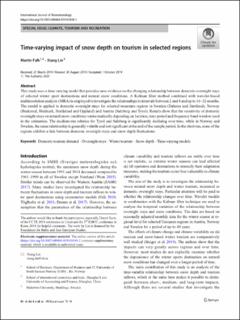| dc.contributor.author | Falk, Martin Thomas | |
| dc.contributor.author | Lin, Xiang | |
| dc.date.accessioned | 2020-03-12T12:58:15Z | |
| dc.date.available | 2020-03-12T12:58:15Z | |
| dc.date.created | 2020-02-13T18:28:17Z | |
| dc.date.issued | 2019 | |
| dc.identifier.citation | International journal of biometeorology. 2019. | en_US |
| dc.identifier.issn | 0020-7128 | |
| dc.identifier.uri | https://hdl.handle.net/11250/2646598 | |
| dc.description | This article is licensed under a Creative Commons Attribution 4.0 International License, which permits use, sharing, adaptation, distribution and reproduction in any medium or format, as long as you give appropriate credit to the original author(s) and the source, provide a link to the Creative Commons licence, and indicate if changes were made. The images or other third party material in this article are included in the article's Creative Commons licence, unless indicated otherwise in a credit line to the material. If material is not included in the article's Creative Commons licence and your intended use is not permitted by statutory regulation or exceeds the permitted use, you will need to obtain permission directly from the copyright holder. | en_US |
| dc.description.abstract | This study uses a time-varying model that provides new evidence on the changing relationship between domestic overnight stays of selected winter sport destinations and natural snow conditions. A Kalman filter method combined with wavelet-based multiresolution analysis (MRA) is employed to investigate the relationships in intervals between 2 and 4 and up to 16–32 months. The model is applied to domestic overnight stays for selected mountain regions in Sweden (Dalarna and Jämtland), Norway (Buskerud, Hedmark, Hordaland and Oppland) and Austria (Salzburg and Tyrol). Results show that the sensitivity of domestic overnight stays on natural snow conditions varies markedly depending on location, time period and frequency band window used in the estimation. The medium-run relation for Tyrol and Salzburg is significantly declining over time, while in Norway and Sweden, the same relationship is generally volatile and not significant at the end of the sample period. In the short run, none of the regions exhibits a link between domestic overnight stays and snow depth fluctuations. | en_US |
| dc.language.iso | eng | en_US |
| dc.rights | Navngivelse 4.0 Internasjonal | * |
| dc.rights.uri | http://creativecommons.org/licenses/by/4.0/deed.no | * |
| dc.title | Time-varying impact of snow depth on tourism in selected regions | en_US |
| dc.type | Peer reviewed | en_US |
| dc.type | Journal article | en_US |
| dc.description.version | publishedVersion | en_US |
| dc.rights.holder | The Author(s) 2020 | en_US |
| dc.source.pagenumber | 13 | en_US |
| dc.source.journal | International journal of biometeorology | en_US |
| dc.identifier.doi | 10.1007/s00484-019-01848-1 | |
| dc.identifier.cristin | 1794013 | |
| cristin.ispublished | true | |
| cristin.fulltext | original | |
| cristin.qualitycode | 1 | |

